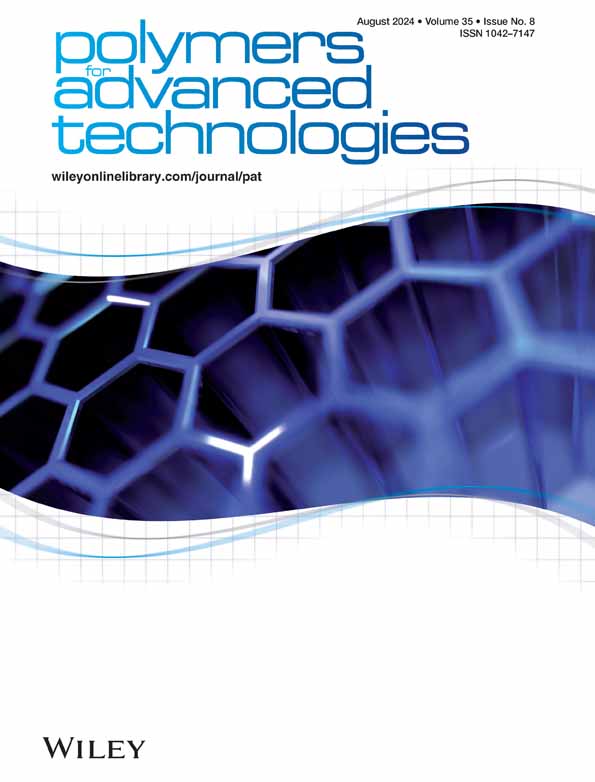Sustainable strategy for the synthesis of novel vegetable oil derived polymeric materials
IF 3.4
4区 工程技术
Q2 POLYMER SCIENCE
引用次数: 0
Abstract
This study reports a sustainable strategy to produce polymeric materials with convenient properties, employing principles close to green chemistry, starting from epoxy/methacrylate vegetable oil monomers. New bio‐based derivatives were obtained from the well‐known epoxidized linseed oil, reacted with a renewable reagent, undecylenic acid, using suitable synthesis parameters in heterogeneous catalysis. The undecylenic double bonds grafted on the linseed oil structure were then reacted, resulting epoxidized undecylenic acid‐linseed oil (monomer 1). Monomer 1 was further used as an intermediate to obtain methacrylic derivatives: monomer 2—methacrylate epoxidized undecylenic acid‐linseed oil (bearing both epoxy and methacrylic moieties) and monomer 3—methacrylate undecylenic acid‐linseed oil (bearing only methacrylic functionalities). These three monomers were employed in different eco‐friendly ultraviolet/visible light curing attempts, proving their ability to generate polymer networks in different reaction conditions. The resulting materials were investigated through different thermal and thermo‐mechanical assays, establishing their general properties. The influence of the undecylenic fragments, epoxy/methacrylate content and curing conditions were established. Gel fraction varied according to the initial precursor composition (62/87% for the epoxy‐based materials; 58/91% for the methacrylic‐based materials). A good elasticity was observed for the new materials (合成新型植物油衍生聚合物材料的可持续战略
本研究报告介绍了一种可持续发展战略,即利用接近绿色化学的原理,从环氧/甲基丙烯酸酯植物油单体出发,生产具有方便特性的聚合物材料。研究人员从众所周知的环氧化亚麻籽油中获得了新的生物基衍生物,并利用异相催化中合适的合成参数与可再生试剂十一碳烯酸进行了反应。接枝在亚麻籽油结构上的十一碳烯双键随后发生反应,生成环氧化十一碳烯酸亚麻籽油(单体 1)。单体 1 还可用作获得甲基丙烯酸衍生物的中间体:环氧化十一烯酸亚麻籽油甲基丙烯酸酯单体 2(同时具有环氧基和甲基丙烯酸基)和十一烯酸亚麻籽油甲基丙烯酸酯单体 3(仅具有甲基丙烯酸官能团)。这三种单体被用于不同的环保型紫外线/可见光固化尝试中,证明了它们在不同反应条件下生成聚合物网络的能力。研究人员通过不同的热学和热力学实验对所得到的材料进行了研究,从而确定了它们的一般特性。研究确定了十一烯酸片段、环氧树脂/甲基丙烯酸酯含量和固化条件的影响。凝胶成分随初始前体成分的不同而变化(环氧基材料为 62/87%;甲基丙烯酸基材料为 58/91%)。新材料具有良好的弹性(Tg 范围为 20 至 44°C)和很高的耐热性(环氧网络的热降解温度为 400/453°C ,甲基丙烯酸网络的热降解温度为 382°C),这与其他已研究过的单官能或双官能聚合物基质非常一致。
本文章由计算机程序翻译,如有差异,请以英文原文为准。
求助全文
约1分钟内获得全文
求助全文
来源期刊

Polymers for Advanced Technologies
工程技术-高分子科学
CiteScore
6.20
自引率
5.90%
发文量
337
审稿时长
2.1 months
期刊介绍:
Polymers for Advanced Technologies is published in response to recent significant changes in the patterns of materials research and development. Worldwide attention has been focused on the critical importance of materials in the creation of new devices and systems. It is now recognized that materials are often the limiting factor in bringing a new technical concept to fruition and that polymers are often the materials of choice in these demanding applications. A significant portion of the polymer research ongoing in the world is directly or indirectly related to the solution of complex, interdisciplinary problems whose successful resolution is necessary for achievement of broad system objectives.
Polymers for Advanced Technologies is focused to the interest of scientists and engineers from academia and industry who are participating in these new areas of polymer research and development. It is the intent of this journal to impact the polymer related advanced technologies to meet the challenge of the twenty-first century.
Polymers for Advanced Technologies aims at encouraging innovation, invention, imagination and creativity by providing a broad interdisciplinary platform for the presentation of new research and development concepts, theories and results which reflect the changing image and pace of modern polymer science and technology.
Polymers for Advanced Technologies aims at becoming the central organ of the new multi-disciplinary polymer oriented materials science of the highest scientific standards. It will publish original research papers on finished studies; communications limited to five typewritten pages plus three illustrations, containing experimental details; review articles of up to 40 pages; letters to the editor and book reviews. Review articles will normally be published by invitation. The Editor-in-Chief welcomes suggestions for reviews.
 求助内容:
求助内容: 应助结果提醒方式:
应助结果提醒方式:


